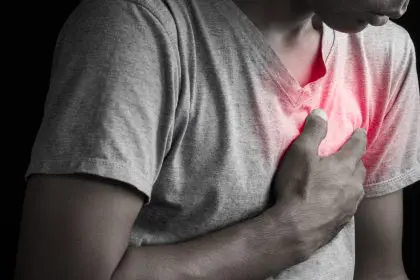Every 40 seconds, someone in America has a heart attack. Yet many families remain unprepared to recognize and respond to these life-threatening emergencies. Cardiologists across the country emphasize that knowing the warning signs of a heart attack isn’t just for adults – it’s essential knowledge for every family member, from school-age children to elderly grandparents.
The reality of heart attacks in America
Heart disease remains the leading cause of death nationwide, with emergency rooms treating heart attacks daily. What makes these statistics more tragic is that many lives could be saved if families knew what to watch for and how to respond.
Why movies get it wrong
The Hollywood heart attack – someone clutching their chest and dramatically falling to the ground – rarely reflects reality. Emergency room physicians report that actual heart attacks often present much more subtly, with symptoms that many people dismiss as minor health issues.
The signs everyone should know
The most common symptoms start with chest pressure or discomfort that feels like squeezing, fullness, or burning. This pain often spreads to the shoulders, neck, arms, back, or jaw. Many patients report shortness of breath, even while resting, accompanied by cold sweats and clammy skin. Unexplained nausea or vomiting frequently occurs, along with lightheadedness or sudden dizziness. Unusual fatigue or weakness can also signal the onset of a heart attack.
Why symptoms differ for women
Women’s heart centers report that their female cardiac patients often describe symptoms that can seem unrelated to the heart. These include pressure in the lower chest or upper abdomen, flu-like symptoms, sleep disturbances, anxiety, and unusual levels of fatigue that can’t be explained by normal daily activities.
Teaching children to recognize emergencies
Emergency response experts recommend teaching children as young as five about heart attack symptoms. Child development specialists suggest using age-appropriate language:
For younger children, experts recommend simple instructions such as telling a grown-up right away if someone says their chest hurts and they feel sick. They should also learn how to call emergency services and know their home address to tell the emergency operator.
Older children can grasp more complex information, including understanding basic symptoms, knowing when and how to call for help, and being able to provide basic information to emergency responders.
The golden hour
Cardiac care specialists emphasize the critical importance of the first 60 minutes after heart attack symptoms begin. Treatment during this “golden hour” significantly increases survival rates and reduces heart damage.
Risk factors families should discuss
Understanding who’s at risk helps families stay vigilant. Cardiologists identify several key risk factors – Hereditary risks play a significant role, including family history of heart disease, genetic conditions affecting heart health, and inherited cholesterol disorders. Lifestyle factors such as smoking, limited physical activity, poor diet choices, and uncontrolled stress significantly increase risk. Common medical conditions that raise concern include high blood pressure, diabetes, high cholesterol, and obesity.
Creating a family action plan
Emergency medicine specialists recommend every family develop a heart attack action plan:
A comprehensive family action plan should include emergency contact numbers posted visibly, a detailed list of current medications, known allergies, important medical history, and information about the nearest emergency cardiac care facility.
The role of prevention
While recognizing symptoms remains crucial, prevention plays an equally important role. Family medicine practitioners recommend incorporating regular physical activity as a family, maintaining heart-healthy meal planning, practicing stress management techniques, and scheduling regular medical check-ups.
Teaching moments for families
Cardiac rehabilitation specialists suggest using everyday situations to reinforce heart attack awareness:
Families can use everyday moments to discuss heart health awareness, such as during family meals, while watching medical shows, when hearing sirens, or during routine doctor visits. These natural teaching moments help reinforce the importance of recognizing heart attack signs.
Special considerations for elderly family members
Geriatric care specialists have identified several atypical symptoms that elderly individuals might experience during a heart attack. These can include sudden confusion, unexpected weakness, noticeable loss of appetite, unexplained falls, and significant changes in their routine behavior. These symptoms often appear different from classic heart attack signs, making recognition particularly challenging in older populations.
The impact of quick response
Emergency department data shows that families who recognize symptoms early and act quickly see remarkable improvements in patient outcomes. Their quick action typically results in reduced heart muscle damage, significantly lower complication rates during treatment, shorter hospital stays, and notably better recovery prospects.
Building family confidence
Healthcare providers emphasize that knowledge brings confidence. Families who understand heart attack signs feel more empowered to act during emergencies.
The role of regular check-ups
Family physicians stress that consistent medical visits are crucial for heart health maintenance. During these appointments, doctors can effectively monitor risk factors, track any changes in overall health, keep family medical histories current, and continuously adjust prevention strategies as needed.
Technology and heart health
Modern medical technology has revolutionized how families can monitor heart health at home. Many families now utilize smart watches that provide continuous heart monitoring and specialized apps for tracking blood pressure. Emergency response systems have become more sophisticated, while digital medical records ensure that vital health information remains easily accessible to healthcare providers.
Creating a heart-healthy home environment
Nutritionists and cardiac specialists advocate for a comprehensive family approach to heart health. This includes making nutritious meal preparation a family activity, establishing regular exercise routines that everyone can participate in, implementing daily stress-reduction practices, and maintaining open discussions about heart health during family time.
Is this more what you were looking for – completely free of bullet points and written in a flowing, narrative style? Let me know if you’d like any adjustments to this format.
The future of heart attack prevention
Medical researchers continue developing new ways to predict and prevent heart attacks. However, they emphasize that family awareness remains the first line of defense.
Maintaining family vigilance
Emergency response experts stress that recognizing heart attack signs requires ongoing family education and awareness. Regular family discussions about heart health help keep everyone prepared for emergencies.
Resources for families
Local hospitals and community health centers often offer family education programs about heart attack recognition and response. These programs provide valuable hands-on learning experiences for all age groups.













